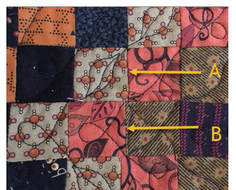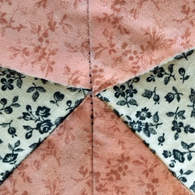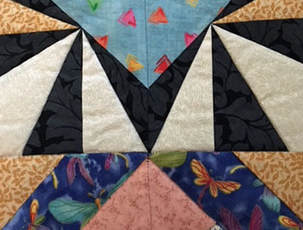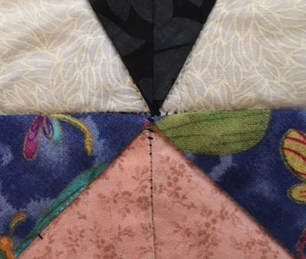|
Piecing is a very large topic, from a judging point of view. After the last 2 posts, there are still a few more points that need to be considered.
Quilters start with fabric that they cut and stitch with accuracy, we hope. We use sewing machines, needles, thread, rulers, scissors, rotary cutters….and don’t forget the iron. Pressing is often an afterthought. It’s what you do when the important stuff…cutting and stitching…is done. “I’ll just give it a quick press……if I have time.” As I was learning to quilt, I had one of those ‘Huh?’ moments (If I had a dollar for every ‘Huh?’....) when I discovered that some quilters actually paid attention to pressing and that some of them even had a pressing plan when they started to piece. When another new-ish quilter at a guild meeting asked me if I pressed my seams to one side or open she might as well have been asking me if I’d ever launched the space shuttle. Totally clueless. It finally, slowly dawned on me that when you start aiming for quality piecing, pressing becomes important. Especially if you’re planning on having your work judged. But wait, how does the judge know what you did with the iron? It’s on the inside. She can’t see it! Yes and No. Some piecing judging points that could be related to pressing can be seen just by looking. For example, shadowing of dark fabric through light fabric, which is not desirable. The quiltermaker might notice this while pressing, and decide to trim the seam allowances to avoid the shadow. Or they might choose to press the seam in another direction. If this was a Harry Potter story, 10 points to Pressing. More often, pressing can be felt. This is one of the main reasons why judges touch the quilts they are judging. You know how sometimes the seam allowance flips from one side of the seam to another in the middle of the seam? An experienced judge can feel that. Will the judge happen to run her fingers over the seam right where that happens? Maybe, maybe not. But as long as you’re at the ironing board, wouldn’t it just be easier to make sure there’s no flip to be found? Pressing really comes into its own where a lot of seams come together, such as in the center of a LeMoyne Star or Pinwheel block. One of the comments I frequently find myself making is something to the effect of ‘Strive for decreased bulk at block centers,’ (or wherever the bulk happens to be.) Other than a nice flat appearance and feel, as with so many other judging points there is a practical advantage to avoiding built up bulk on the quilt. Any area that sticks up on the surface of a quilt is going to be more susceptible to wear and tear. Some areas that suffer from wear and tear, like the edge of the binding, can be easily repaired, but the middle of a block is another magnitude of difficulty. Another 10 points to Pressing. And now a pressing hint, that has absolutely nothing to do with judging. Some years back a friend of mine sent me a link to a video about pressing with a clapper (a tool originally used in tailoring) and steam. (Yeah, I know, bad steam.) I do a lot of improv piecing with seams of all sizes and angles and this thing really works. You get flat seams. As a blogger for NACQJ, I probably shouldn't actually tell you where I bought mine, but if you google ‘pressing with a clapper’ you’ll find lots of info. Take that, bulk! Stacy Koehler, Secretary, NACQJ NQA Certified Judge Qualified to Evaluate Masterpiece Quilts
0 Comments
Yes, there’s more. While the most obvious element of piecing is how the seam intersections meet, which was cover in the last post, there are a number of other points that make for good quality work. Consider cutting. Before you ever thread a needle, you cut your fabric and how well this is done will show up in the finished piecing. All like patches (for example: the squares making up a 9 Patch block) should be the same size and shape. Although these can get distorted at any number of other points, clean, accurate cutting is the foundation for good piecing.  Although there are a lot of piecing issues between Patch A and Patch B, a strong contributor to the problem is that Patch A is smaller than Patch B, in a block that needs all its patches to be the same size. Given that they start out inaccurately cut, they could never be pieced accurately. Attention to grain line/bias during the cutting process will also contribute to a crisp result. There should be no distortions in the finished piecing caused by inattention to grain. Similarly, awareness of the printed design on the fabric is important. Careful manipulation or control of directional elements will either enhance the piecing, if done well, or detract from it if the directional elements draw negative attention. It is not unusual for smart use of fabric to be significant in a quilt’s success. Next, all the things related to thread and stitching. Thread should match or blend with the fabric. Keep in mind that the judge will likely check the seams carefully, at least in a few places on the quilt. Just because a discordant thread isn’t visible from a distance doesn‘t mean it won’t be picked up on closer examination. Choice of an appropriate thread for piecing is a one-and-done, easy thing to do correctly. It’s just as simple to thread up and wind bobbins from a well-chosen spool of thread as it is to use a poorly chosen spool.  Why yes, that is black thread. Sometimes, even if the stitches don't show, the presence of dark thread under light fabric can make the seam look dirty, almost as if the stiching lines were marked with pencil that was not removed. Stitching should be secure, with good tension. When the judge gets up close and spreads a seam, the stitch should stay firm, not stretch apart. No open seams or loose fabric edges should be visible. Thread ends and knots should be hidden.  Doesn't look too bad from here...  ...but up close it's another story. Maybe the judge won't notice. So your fabric choices are well made, the patches are well cut, the thread is right on the money. Other than accurate piecing, which was covered in the last post, can there really be more?
Yup. Stacy Koehler, Secretary, NACQJ NQA Certified Judge Qualified to Evaluate Masterpiece Quilts |
AuthorStacy Koehler became an NQA Certified Judge in 2005. She is a current member of the National Association of Certified Quilt Judges and has served as the new organization's Secretary. She loves quilts and quilters and believes that a well-judged quilt can be a positive influence in its maker's individual development and contribute to the continued growth of the art of quiltmaking. Archives
July 2018
Categories |



 RSS Feed
RSS Feed